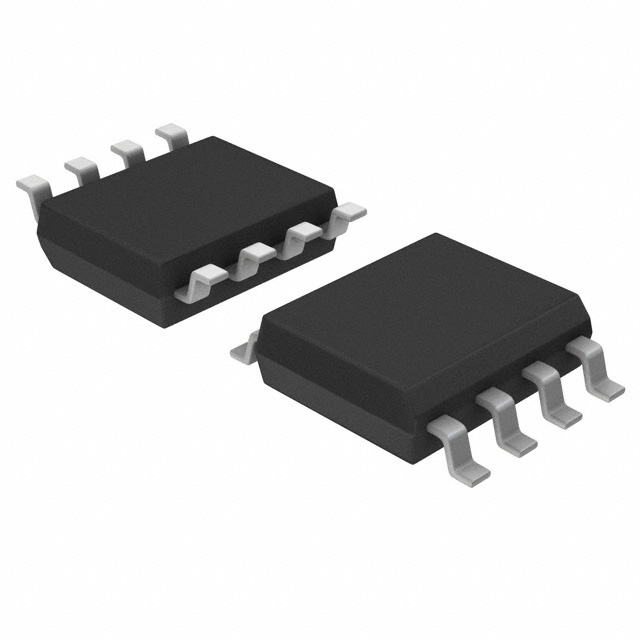Consulte las especificaciones para obtener detalles del producto.

LM258DRE4
Product Overview
Category: Integrated Circuit (IC)
Use: LM258DRE4 is a dual operational amplifier that is designed to operate from a single power supply over a wide range of voltages. It is commonly used in various electronic circuits where amplification and signal conditioning are required.
Characteristics: - Dual Operational Amplifier - Wide operating voltage range - Low input offset voltage - Low input bias current - High gain bandwidth product - Low power consumption
Package: LM258DRE4 is available in an 8-pin SOIC (Small Outline Integrated Circuit) package.
Essence: The essence of LM258DRE4 lies in its ability to amplify and condition electrical signals with high precision and low power consumption.
Packaging/Quantity: LM258DRE4 is typically sold in reels or tubes, with each reel/tube containing a specific quantity of ICs. The exact packaging and quantity may vary depending on the supplier.
Specifications
- Supply Voltage Range: 3V to 32V
- Input Offset Voltage: 2mV (maximum)
- Input Bias Current: 20nA (maximum)
- Gain Bandwidth Product: 1MHz (typical)
- Slew Rate: 0.3V/µs (typical)
- Operating Temperature Range: -40°C to +125°C
Detailed Pin Configuration
LM258DRE4 has a total of 8 pins, which are labeled as follows:
- V+ (Positive Power Supply)
- IN- (Inverting Input of Op-Amp 1)
- IN+ (Non-Inverting Input of Op-Amp 1)
- V- (Negative Power Supply)
- OUT (Output of Op-Amp 1)
- IN- (Inverting Input of Op-Amp 2)
- IN+ (Non-Inverting Input of Op-Amp 2)
- VCC+ (Positive Power Supply)
Functional Features
- Dual Operational Amplifier: LM258DRE4 consists of two independent operational amplifiers in a single package, allowing for versatile circuit designs.
- Wide Operating Voltage Range: It can operate from a single power supply within the range of 3V to 32V, making it suitable for various applications.
- Low Input Offset Voltage: The input offset voltage is minimized to ensure accurate amplification and signal conditioning.
- Low Input Bias Current: LM258DRE4 exhibits low input bias current, reducing the impact of input loading on the circuit performance.
- High Gain Bandwidth Product: With a typical gain bandwidth product of 1MHz, it can handle a wide range of frequencies.
- Low Power Consumption: LM258DRE4 is designed to consume minimal power, making it suitable for battery-powered applications.
Advantages and Disadvantages
Advantages: - Versatile dual operational amplifier - Wide operating voltage range - Accurate amplification with low input offset voltage - Low power consumption
Disadvantages: - Limited gain bandwidth product compared to some specialized operational amplifiers - Not suitable for high-frequency applications requiring very high slew rate
Working Principles
LM258DRE4 operates based on the principles of operational amplifiers. It amplifies the difference between its two input terminals and produces an output voltage that is proportional to this difference. By adjusting the feedback network, the gain and characteristics of the amplifier can be tailored to specific requirements.
Detailed Application Field Plans
LM258DRE4 finds applications in various fields, including but not limited to: - Audio amplification circuits - Signal conditioning circuits - Active filters - Instrumentation amplifiers - Voltage regulators - Oscillators
Detailed and Complete Alternative Models
Some alternative models that can be considered as alternatives to LM258DRE4 are: - LM358 - LM324 - TL072 - NE5532 - OP07
These alternative models offer similar functionality and characteristics, but may have slight differences in specifications and pin configurations. It is recommended to refer to the datasheets of these models for detailed information.
In conclusion, LM258DRE4 is a versatile dual operational amplifier that offers accurate amplification and signal conditioning capabilities. With its wide operating voltage range and low power consumption, it finds applications in various electronic circuits. While it may have some limitations in terms of gain bandwidth product and high-frequency performance, there are alternative models available to suit specific requirements.
Enumere 10 preguntas y respuestas comunes relacionadas con la aplicación de LM258DRE4 en soluciones técnicas
Sure! Here are 10 common questions and answers related to the application of LM258DRE4 in technical solutions:
Q: What is LM258DRE4? A: LM258DRE4 is a dual operational amplifier (op-amp) that is commonly used in various electronic circuits.
Q: What is the voltage supply range for LM258DRE4? A: The voltage supply range for LM258DRE4 is typically between 3V and 32V.
Q: What is the maximum output current of LM258DRE4? A: The maximum output current of LM258DRE4 is around 40mA.
Q: Can LM258DRE4 be used as a comparator? A: Yes, LM258DRE4 can be used as a comparator, but it has limited speed compared to dedicated comparators.
Q: What is the input offset voltage of LM258DRE4? A: The input offset voltage of LM258DRE4 is typically around 2mV.
Q: Is LM258DRE4 suitable for low-power applications? A: Yes, LM258DRE4 is suitable for low-power applications as it has a low quiescent current consumption.
Q: Can LM258DRE4 operate in single-supply configurations? A: Yes, LM258DRE4 can operate in single-supply configurations, but proper biasing may be required.
Q: What is the common-mode rejection ratio (CMRR) of LM258DRE4? A: The CMRR of LM258DRE4 is typically around 70dB.
Q: Can LM258DRE4 drive capacitive loads? A: Yes, LM258DRE4 can drive capacitive loads, but it may require additional compensation to maintain stability.
Q: What are some typical applications of LM258DRE4? A: LM258DRE4 is commonly used in audio amplifiers, active filters, voltage regulators, and other signal conditioning circuits.
Please note that the answers provided here are general and may vary depending on specific datasheet specifications and application requirements.

